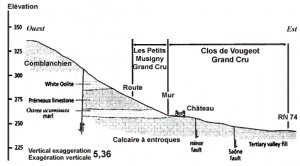Geology
Localization of Burgundy

Situated 250 km south of Paris, Burgundy spreads out over 31,752 km²… The relief is relatively gentle, consisting of a collection of plains to the east, a more undulating region to the centre with an altitude of 400 to 900 metres in Morvan and finally a zone to the west which generally does not measure over 300 metres in altitude.
The geographical diversity of Burgundy results in a diversity of climates and the existence of microclimates. The annual hours of sun are approximately 2,000 and the average temperature is 11.5°C.
Geology of Burgundy
 Rocks, landscape, and terroir are the heritage of a rich past deeply etched in the soil. Approximately 300 million years ago, Burgundy was a mountainous country located near the equator with a hot and humid climate. During the Secondary Age (-245 to -65 million), the continent moved and the sea advanced.
Rocks, landscape, and terroir are the heritage of a rich past deeply etched in the soil. Approximately 300 million years ago, Burgundy was a mountainous country located near the equator with a hot and humid climate. During the Secondary Age (-245 to -65 million), the continent moved and the sea advanced.
During the Jurassic Period (-205 to -135 million) the sea level fluctuated, tectonic plates moved, the landscape of oolitic dunes, which would in time give calcareous scarps, separated the vast central lagoon of the sea and its various currents. The clayey depths, the result of minerals altering, would eventually form marl.In total, close to 2000 metres of land piled up like a gigantic millefeuille in which, under the weight of sediment and as a result of the plates stretching, the relief sculpted itself.
During the Tertiary Age, approximately 60 million years ago, pressure from the African plate pushed Burgundy out of the water. The weather was still hot and humid. Again pressure from both the African ad European plates caused Burgundy to bend and fracture leaving great fault lines to this day. Erosion then took over; rivers forged themselves and caves and underground tunnels formed in the limestone.
During the Quaternary Age (approximately 2 million years ago) a bitter cold settled in. Glaciers succeeded in shattering rocks, eroding and washing away debris. For the last 15,000 years the climate has been much milder and we no longer speak of alternating periods of hot and cold. Man settled here definitively approximately 6,000 to 7,000 years ago (during the Neolithic period).
La Côte de Nuits
Côte de Nuits is formed on limestone from the middle Jurassic age. As its name indicates, Côte de Nuits also consists of a fairly sloping relief.
The various clay and limestone soils, the solar exposures as well as the climate conditions resulting from the formation of small valleys perpendicular to the fault line, all work to give a very fragmented AOC classification system.
The vineyards of Côte de Nuits are spread throughout 8 villages, from Dijon to Corgoloin, with 3000 hectares under production. The red wines represent 92% of production and are made up of Pinot Noir. The white wines, produced from Chardonnay, represent only 8% of production.


